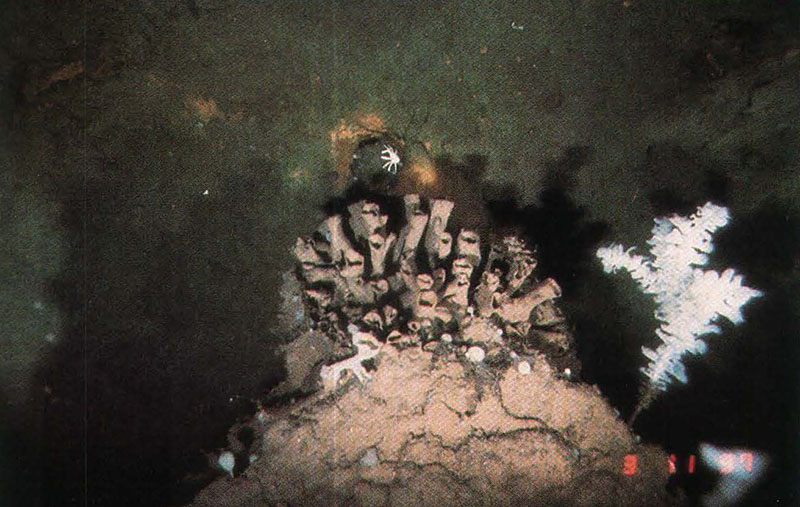Escanaba Trough: Exploring the Seafloor and Oceanic Footprints
May 26 - June 14, 2022
Hydrothermal Systems in Escanaba Trough
Hydrothermal systems occur when seawater percolates down through fractures in the oceanic crust, heating up as it nears the earth’s hot interior. These systems are often found near mid-ocean ridges such as Escanaba Trough, where tectonic plates diverge, and new seafloor is created.
In hydrothermal systems, descending seawater interacts with oceanic crust, removing chemicals from the rocks as it heats to 350-400 degrees Celsius (650-750 degrees Fahrenheit), about four times hotter than boiling water. (Extreme pressure in the ocean’s depths prevents fluids from boiling). This interaction of seawater and crust produces hydrothermal fluid, a chemically modified slurry of gases and dissolved elements, including metals.
The superheated fluid is then ejected back up to the seafloor and promptly chilled by near-freezing ocean bottom waters. Chemicals dissolved in the fluid precipitate at the vent, forming chimney-like deposits and supporting deep-sea chemosynthetic communities—organisms that rely on chemicals rather than photosynthesis to fuel their metabolism.
The discovery of modern hydrothermal systems dates to a 1977 research expedition to the Galapagos Rift and East Pacific Rise, which encountered chemosynthetic fauna that the expedition’s geology team famously preserved in vodka. Less attention is paid to the fact that this team of geologists, geochemists, and geophysicists found exactly what they had predicted: A heat-driven region of seafloor spreading and mineral precipitation, based on studying ancient analogues on land and studying heat flow on the seafloor.
Now, after 45 years of excitement and discovery around active hydrothermal systems and the ecosystems they support, interest has turned towards the more subtle ways in which hydrothermal systems evolve over time, eventually becoming severed from the heat and fluid-flow pathways responsible for their formation.

At Escanaba Trough, for example, there is little current hydrothermal activity, making it a good place to study how hydrothermal systems transform and persist after heat sources become less active, as well as in regions further from high-temperature fluid flow.
Central to this research is the concept of chemical equilibrium. Minerals and chemicals formed under one set of circumstances are said to be in equilibrium—their composition and concentration are balanced, given the circumstances. Picture a sealed bottle of soda: The liquid inside the bottle contains dissolved carbon dioxide, and there is carbon dioxide gas in the space between the liquid and the cap. Carbon dioxide is moving constantly between the liquid and gas phases within the bottle, but the contents don’t appear to change. The system is in equilibrium.
When minerals and chemicals shift to a different set of circumstances, they go out of equilibrium, and must seek balance with their new surroundings. These transformations from equilibrium to disequilibrium may occur rapidly, in less than a second—imagine opening that sealed soda bottle with an effervescent hiss—or they may occur slowly, over millions of years.
The atmosphere of Earth is an example of how chemical equilibrium changes over geologic time: The concentrations of oxygen, nitrogen, methane, and carbon dioxide on Earth today are different than they were when the planet formed 4.5 billion years ago. This is largely because Earth supports life, and organisms produce gases that constantly modify the composition of Earth’s atmosphere.
The disequilibrium that occurs in hydrothermal systems is both very rapid—when hydrothermal fluid vents to cold seawater—and slowly unfolding, as minerals transform through their interaction with seawater. The chemosynthetic organisms making use of this phenomenon remain poorly understood; samples taken during the Escanaba Trough expedition will help to characterize the chemical and biological conditions that accompany the evolution of hydrothermal systems.
By Amy Gartman, Principal Investigator; Research Oceanographer, U.S. Geological Survey Pacific Coastal and Marine Science Center
Published June 3, 2022
Re-posted with permission from original article.